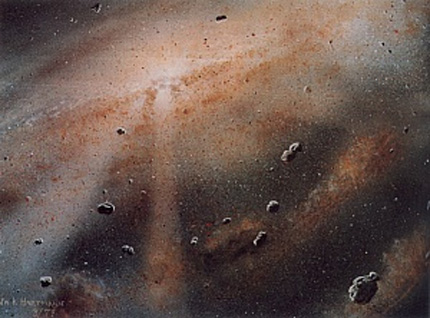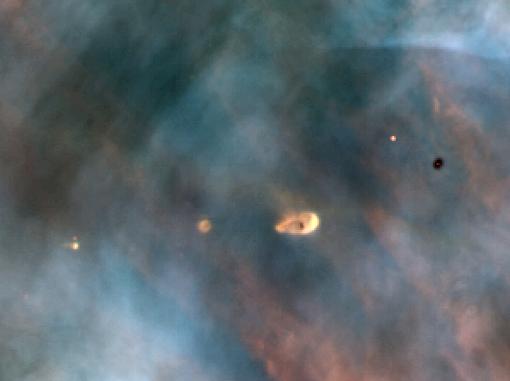
| Palaeos: |  |
The Chaotian Eon |
| Chaotian | The Eochaotian Era |
| Timescale Main Page
Earth's forgotten youth, and beyond Neochaotian - Planetary accretion Hadean Archean Proterozoic Phanerozoic |
Introduction - The Chaotian Eon The Pre-solar nebula References |

Shock waves through icy parts of the solar nebula may be the mechanism that enriched ancient meteorites (called chondrites) with water -- water that some believe provided an otherwise dry Earth with oceans. Source - NASA, artwork © W.K. Hartmann

The Ancient of Days by William Blake. 1794; Relief etching with watercolor, 23.3 x 16.8 cm; British Museum, London. Although Ancient of Days is one of the names of God in Aramaic, Greek, and Laton, the former (Atik Yomin) and occurring in Jewish mysticism as the highest emanation of the Godhead, Blake's relief etching represents a more complex and nuanced archetype, which he calls Urizen, the embodiment of conventional reason and law. Blake's visionary artwork, as with Milton's Paradise Lost and more recently Philip Pullman's His Dark Materials (influenced by both Blake and Milton) reinterpreted and subverted traditional religious themes (note that "The Golden Compass" of Pullman's first novel was not, as portrayed in the film, a navigation instrument but a compass or drawing instrument as per Blake's illustration above). MAK110904 |
We begin at the beginning... (well, not exactly, there's still 8 billion years of cosmic evolution)
In our review of the earliest periods of geological and solar system time, we have adopted the terminology proposed by Goldblatt et al. 2010, who refer to two eons (Chaotian and Hadean), five eras, and ten periods. The authors explain:
"We suggest two Chaotian eras, each era with two periods. The Eochaotian begins when the Solar Nebula became a closed system with respect to the rest of the giant molecular cloud and encompasses the agglomeration of the Solar System constituents from the nebula. It includes the Nephelean Period, for the cloud that is the nebula, and the Erebrean Period (Erebus, darkness) for the proto-Sun, yet to be luminous. The Neochaotian Era begins with the first light from the Sun...Events and material from before the nebula are Prenephelean. We recommend that this term replace "presolar" for meteorite grains that formed before the nebula (Nittler, 2003), in contrast to within the nebula but before the Sun."
-- Goldblatt et al. 2010 p.2
With the usual geographic and stratigraphic regions being rather thing on the ground, Inspiration for these names is derived from mythology, specifically the works of Hesiod and Milton. Hesiod describes creation (Theogony 116-):
"Verily at the first Chaos came to be, but next
wide-bosomed Gaea [Earth]. From Chaos came
forth Erebus [darkness] and black Nyx [Night]; but
of Nyx were born Aether [the bright upper atmosphere]
and Hermera [Day]. . . "
From Milton (Paradise Lost II, 907-):
". . . Chaos Umpire sits,
And by decision more imbroiles the fray
By which he Reigns; next him high Arbiter
Chance governs all. Into this wilde Abyss,
The Womb of nature and perhaps her Grave. . .
Unless th' Almighty Maker them ordain
His dark materials to create more Worlds"
Editor's note: I'm just copying this basic intro from Wikipedia; essentially, this is just a basic place holder page, to serve as a lead in to the Hadean. In the future a proper account could be added here, if someone wants to contribute. But the Wikipedia entry is quite well referenced and should serve well enough MAK110904
The formation and evolution of the Solar System is estimated to have begun 4.568 billion years ago with the gravitational collapse of a small part of a giant molecular cloud. Most of the collapsing mass collected in the centre, forming the Sun, while the rest flattened into a protoplanetary disk out of which the planets, moons, asteroids, and other small Solar System bodies formed (link, link). This widely accepted model, known as the nebular hypothesis, was first developed in the 18th century by Emanuel Swedenborg, Immanuel Kant, and Pierre-Simon Laplace. Its subsequent development has interwoven a variety of scientific disciplines including astronomy, physics, geology, and planetary science. Since the dawn of the space age in the 1950s and the discovery of extrasolar planets in the 1990s, the models have been both challenged and refined to account for new observations.
The nebular hypothesis maintains that the Solar System formed from the gravitational collapse of a fragment of a giant molecular cloud. (Montmerle et al 2006) The cloud itself had a size of about 20 pc, (Montmerle et al 2006) while the fragments were roughly 1 pc (three and a quarter light-years) across. (Zabludoff 2003) The further collapse of the fragments led to the formation of dense cores 0.01-0.1 pc (2,000-20,000 AU) in size. (Montmerle et al 2006) (Rawal 1986). One of these collapsing fragments (known as the pre-solar nebula) would form what became the Solar System. (Irvine 1983). The composition of this region with a mass just over that of the Sun was about the same as that of the Sun today, with hydrogen, along with helium and trace amounts of lithium produced by Big Bang nucleosynthesis, forming about 98% of its mass. The remaining 2% of the mass consisted of heavier elements that were created by nucleosynthesis in earlier generations of stars. (Zeilik & Gregory 1998 p. 207) Late in the life of these stars, they ejected heavier elements into the interstellar medium. (Lineweaver 2001)

Hubble Space Telescope image of probable protoplanetary discs in the Orion Nebula, a light-years-wide "stellar nursery" probably very similar to the primordial nebula from which our Sun formed . This view of a small portion of the Orion Nebula, captured by the Wide Field and Planetary Camera 2, reveals five young stars. Four of the stars are surrounded by gas and dust trapped as the stars formed, but were left in orbit about the star. They seem to be protoplanetary disks, or proplyds, that might evolve on to agglomerate planets. The proplyds which are closest to the hottest stars of the parent star cluster are seen as bright objects, while the object farthest from the hottest stars is seen as a dark object. The field of view is only 0.14 light-years across. The Orion Nebula star-birth region is 1500 light-years away, in the direction of the constellation Orion. Image and caption from Wikipedia - image by NASA, public domain |
Studies of ancient meteorites reveal traces of stable daughter nuclei of short-lived isotopes, such as iron-60, that only form in exploding, short-lived stars. This indicates that one or more supernovae occurred near the Sun while it was forming. A shock wave from a supernova may have triggered the formation of the Sun by creating regions of over-density within the cloud, causing these regions to collapse. (Williams 2010). Because only massive, short-lived stars produce supernovae, the Sun must have formed in a large star-forming region that produced massive stars, possibly similar to the Orion Nebula (Hester et al 2004; Bizzarro et al 2007). Studies of the structure of the Kuiper belt and of anomalous materials within it suggest that the Sun formed within a cluster of stars with a diameter of between 6.5 and 19.5 light-years and a collective mass equivalent to 3,000 Suns. (Portegies Zwart 2009) Several simulations of our young Sun interacting with close-passing stars over the first 100 million years of its life produce anomalous orbits observed in the outer Solar System, such as detached objects. (Kaib & Quinn 2008)
Because of the conservation of angular momentum, the nebula spun faster as it collapsed. As the material within the nebula condensed, the atoms within it began to collide with increasing frequency, converting their kinetic energy into heat. The centre, where most of the mass collected, became increasingly hotter than the surrounding disc. (Zabludoff 2003) Over about 100,000 years, (Montmerle et al 2006) the competing forces of gravity, gas pressure, magnetic fields, and rotation caused the contracting nebula to flatten into a spinning protoplanetary disc with a diameter of ~200 AU (Zabludoff 2003) and form a hot, dense protostar (a star in which hydrogen fusion has not yet begun) at the centre. (Greaves 2005)
At this point in its evolution, the Sun is believed to have been a T Tauri star. (Caffe et al 1987). Studies of T Tauri stars show that they are often accompanied by discs of pre-planetary matter with masses of 0.001-0.1 solar masses. (Momose et al 2003) These discs extend to several hundred AU—the Hubble Space Telescope has observed protoplanetary discs of up to 1000 AU in diameter in star-forming regions such as the Orion Nebula (Padgett et al 1999) and are rather cool, reaching only a thousand kelvins at their hottest. (Küker et al 2003). Within 50 million years, the temperature and pressure at the core of the Sun became so great that its hydrogen began to fuse, creating an internal source of energy that countered gravitational contraction until hydrostatic equilibrium was achieved (Yi et al 2001)This marked the Sun's entry into the prime phase of its life, known as the main sequence. Main sequence stars derive energy from the fusion of hydrogen into helium in their cores. The Sun remains a main sequence star today. (Zeilik & Gregory 1998 p. 320)
Links: Formation of the Solar System; A Possible Sequence of Events for the Formation of the Solar System - astronomyonline.org; Astro 1: `Slides' for Class 43 - The Formation of the Sun and Planets page by Niel Brandt
| Page Back | Unit Home | Page Top | Page Next |
Page by MAK110904, edited RFVS111024; incorporated content by Wikipedia, NASA, and Goldblatt et al. 2010, and other sources.